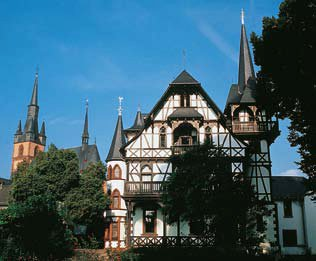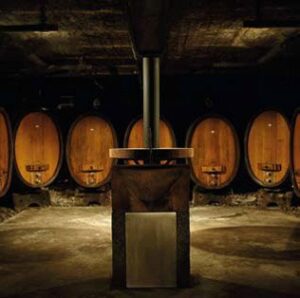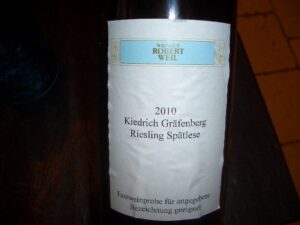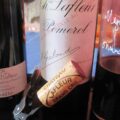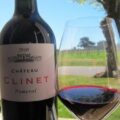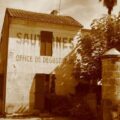A few days ago I attended a barrel-tasting of the upcoming vintage 2010 by the prestigious estate Robert Weil from the region Rheingau. The tasting clearly proved what I heared from several German winemakers in the last weeks and months that the German vintage 2010 is a dream vintage for sweet Riesling. BUT the quantity is very low.
.
The 2010 sweet German Rieslings showed a remarkable flavor density with a visible ripe acidity but good integrated. In addition finesse and huge minerality. No doubt, the vintage 2010 was a real challenge for the german winemakers but it seems that the few TOP winemakers produced some stunning Rieslings. But again, be fast buying these wines, when they arrive in late summer or autumn.
“The estate Robert Weil in the region Rheingau was founded in 1875. The Rheingau is a unique, self-contained region on the Rhine where the man-made landscape and the vine are at one. Its long viticultural tradition was established by monasteries and large aristocratic wine estates. Despite its demands on soil and climate, the Riesling grape thrives here and is inextricably linked with the Rheingau and its viticulture. Weingut Robert Weil, one of the region’s younger estates, is located in the heart of Kiedrich, a village first documented in 950. Its profile is marked by the artworks and architecture of the Gothic parish church St. Valentine, aristocratic Gothic, Renaissance manors, and the tower of Scharfenstein castle, a former residence of the electors and archbishops of Mainz.The estate cultivates 75 ha (185 acres) of vineyards planted with Riesling (99 %) and Pinot Noir (1 %) grapes. Wilhelm Weil, the great-grandson of the estate’s founder, carries on the tradition of uncompromising, quality-oriented practices in the vineyards and in the cellars. The historical manor house, the ultra-modern cellars and the vinothek stand side by side in a beautiful park – the same synthesis of old and new that is reflected in the estate’s philosophy of winemaking.”
Although the Rheingau is one of Germany’s smaller wine-growing regions, its 3,100 ha (7,660 acres) of vineyards are vastly diverse in their geological makeup. They can be divided into three zones: vineyards in proximity to the Rhine, vineyards on the higher reaches of the middle plateau, and vineyards on the heights at the foothills of the Taunus Hills. Among these highlying sites (up to 240 m/780 ft in altitude) surrounding Kiedrich lie the three steep hillside sites of Weingut Robert Weil: Kiedricher Klosterberg, Kiedricher Turmberg and Kiedricher Gräfenberg. The microclimate of these three southwest-facing sites is excellent, with perfect exposure to the sun and correspondingly high temperatures as well as good circulation from the Taunus winds drawn into the Rhine Valley.
Furthermore, the vines are able to permeate the stony soils and develop deep roots, while the water-retaining soil layers ensure the vines a good water supply. Inclination (up to 60 %), exposure (southwest) and the ability of the barren stony soils to absorb heat are the factors that make for three perfect Riesling sites. These conditions, as well as ideal circulation, enable the grapes to remain on the vine for a long time, ripening well into November. Wines made from the loose clusters of small, intensely flavored berries are picture-perfect Riesling wines with a fine acidity and distinctive mineral tone. At the same time, they are marked by elegance and finesse.
Estate Robert Weil has the same high standards for operations in the vineyard and in the cellar. The most modern technical know-how is combined with proven methods of traditional winemaking to preserve and fully realize the potential of what nature provides.
Harvested grapes are handled as gently as possible, starting with their journey from the vineyards to the cellars. Natural sedimentation is used to fine the must, after which oenologists decide whether the juice is best processed in stainless steel tanks or traditional oak casks. Fermentation is temperature controlled, strictly monitored, and lasts from six to twelve weeks. If natural sweetness is to be retained, fermentation is interrupted through temperature reduction. This results in a very fine residual sweetness derived from fructose.
Further vinification takes place in stainless steel tanks of varying sizes (depending on the size of an individual lot) and in traditional mature oak casks (“Rheingauer Stückfass”: 1,200 liters). Yeast contact and stirring (bâtonnage) is also used. After a slow fermentation and aging, the wines are sterile filtered and bottled as gentle as possible in order to retain the wonderful primary grape aromas and for additional aging in the bottle.
well made
2010 Estate Kiedricher Riesling trocken
BRAVO……fascinating fruit density for an estate Riesling. Good balance, ripe acidity and a great inner density in the finish. BUY
2010 Turmberg trocken
power with fine density of flavors and minerality
2010 Gräfenberg trocken
remarkable subtle fruit, very good structure
2010 Rheingau Kabinett
Gorgeous food-wine! elegant fruit and helpful acidity. FOOD-WINE
2010 Turmberg Spätlese
WOW…….never-ending length, crystal-clear fruit and notes of blossoms, Outstanding!!! BUY
fine
2010 Gräfenberg Auslese
Simply to die for! Deep, deep fruit and what a length. BUY
2010 Gräfenberg BA
NO
2010 Gräfenberg TBA
nectar of the gods

